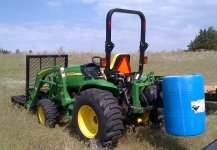Aaron, you quoted Weldermike, who provided perhaps the only useful "experience" in this whole 14 pages. I should have picked up on it sooner but was de-railed by his F-bombs. Ooops, I need to read better between the lines.
You can work a small machine past its capabilities no doubt, ive done it in the past, but it comes with experience. Smaller wire, pre heating, beveling, open roots etc
Well said Mike. This is exactly what people with 120v welders need to know, and need help with. I have never considered smaller wire as a way to solve some of the problems but seems it might help allowing more time for heat to build up. Is that how it works?
Often a job is entirely below 1/4" with just a couple inches of weld exceeding 1/4". It can be many times stronger than stick-poop that they will do, especially when they think a stick-welder solves every problem 120v MIG poses. They really do believe a tick-welder is the simple answer, don't you think that's could be more dangerous? Beveling, preheating, there are many easy options and basically intelligent people can learn these tricks, they are useful with thicker material projects (in the future). I saw a trailer hitch on a van a month ago that was just a pile of welding berries mixed with slag.
the reason we argue the fact constantly is people get a false positive of the capabilities of there machine. Alot of people just buy a machine and jump on the first bit of advise that suits there needs and they are off to the races with the "thats exactly what i wanted to hear" advise.
I understand what you are saying, but disagree in the course taken. There will be problems always but there will be much much more success. I request to
teach them how to do it, and how to find the true limits rather than exaggerate the low side.
You don't think they can handle it, will get all crazy and try to weld the space shuttle? Probably not. They have small projects. Only a fool would buy a 120v for large projects, it says the limits right on the outside of the BOX! This fool would have the same (or more) problems with a 220v MIG or a perhaps worse with a stick welder.
There are so many projects that members can do, learning that are so well-within the capabilities of a 120v welder. 120v tops out around 1/4". Beginners, for safety, should probably not weld bigger, heavier projects which have larger possibility of causing bigger heavier problems. Many many projects, especially learning projects, are at 1/4" or below.
Factory welds on most shlt are garbage for sure, but they are usually undercut and sloppy. Heres the differance between both. Undercut and sloppy means the equipment comes home still hanging. Cold lap means shlt is gone, on the highway, in a field, on someones head, or breaks off the back of a atv going up hill and crashes into your son with a pole saw hanging out of it that was following you. They serve a purpose no doubt, but just not for what most people believe. Dont be so quick on judging comments or advise.
Mike your final paragraph is "quick judge advice". Do you trust members repeating this "advice" without really understanding it, more than you trust them to actively LEARN how to use a 120v welder?
